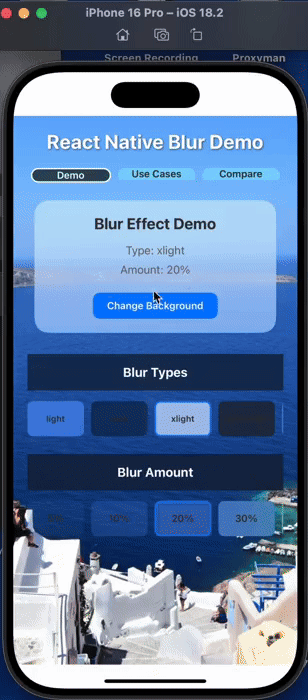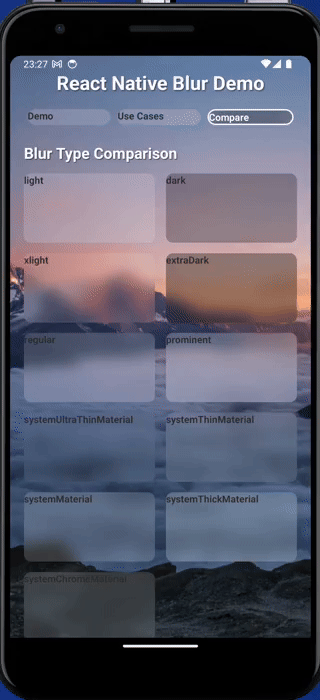A modern React Native blur view component that provides native blur effects for both iOS and Android platforms.
- 🎨 Multiple Blur Types: Support for various blur styles including system materials on iOS
- 📱 Cross-Platform: Works on both iOS and Android
- ♿ Accessibility: Automatic fallback for reduced transparency settings
- 🔧 TypeScript: Full TypeScript support with proper type definitions
- 🚀 Turbo Module: Built with React Native's new architecture (Fabric)
- 🎯 Customizable: Adjustable blur intensity and fallback colors
- 💡 Performance Optimized: Uses hardware acceleration for smooth rendering
- 🛠️ Easy to Use: Simple API for quick integration into your React Native projects
- 📦 Modern: Uses Kotlin for Android implementation and will use Swift for iOS, ensuring modern development practices
This library is fully compatible with both React Native architectures:
- ✅ New Architecture (Fabric): Full support with Turbo Modules
- ✅ Old Architecture (Paper): Backward compatibility maintained
Both architectures have been tested and work perfectly without any additional configuration required.
npm install @sbaiahmed1/react-native-blur
# or
yarn add @sbaiahmed1/react-native-blurRun pod install:
cd ios && pod install- Minimum SDK: API level 24 (Android 7.0)
- Target SDK: API level 35 (Android 15)
- Compile SDK: API level 35 (Android 15)
- Gradle: 8.10.2
- Kotlin: 2.0.21
The Android implementation uses the BlurView library by Dimezis:
implementation 'com.github.Dimezis:BlurView:version-2.0.6'The Android implementation leverages the BlurView library to provide real blur effects:
-
Real-time Blur: Uses
RenderEffectBlurfor hardware-accelerated blur rendering - Hardware Acceleration: Utilizes GPU rendering for optimal performance
- Multiple Blur Algorithms: Supports different blur implementations based on device capabilities
- Performance Optimized: Efficient blur rendering with minimal impact on app performance
- Fallback Handling: Gracefully handles devices with limited graphics capabilities
- No Extra Permissions: Does not require additional Android permissions
import React from 'react';
import { View, Text } from 'react-native';
import { BlurView } from '@sbaiahmed1/react-native-blur';
export default function App() {
return (
<View style={{ flex: 1 }}>
<BlurView
blurType="light"
blurAmount={20}
style={{
position: 'absolute',
top: 100,
left: 50,
right: 50,
height: 200,
borderRadius: 20,
}}
>
<Text>Content with blur background</Text>
</BlurView>
</View>
);
}import React from 'react';
import { BlurView } from '@sbaiahmed1/react-native-blur';
function MyComponent() {
return (
<BlurView
blurType="systemMaterial"
blurAmount={50}
reducedTransparencyFallbackColor="#FFFFFF80"
style={{
padding: 20,
borderRadius: 15,
}}
>
<Text>Advanced blur with custom fallback</Text>
</BlurView>
);
}| Prop | Type | Default | Description |
|---|---|---|---|
blurType |
BlurType |
'light' |
The type of blur effect to apply |
blurAmount |
number |
10 |
The intensity of the blur effect (0-100) |
reducedTransparencyFallbackColor |
string |
undefined |
Fallback color when reduced transparency is enabled |
style |
ViewStyle |
undefined |
Style object for the blur view |
children |
ReactNode |
undefined |
Child components to render inside the blur view |
The following blur types are supported:
-
'light'- Light blur effect -
'dark'- Dark blur effect -
'xlight'- Extra light blur effect -
'extraDark'- Extra dark blur effect
-
'regular'- Regular blur (iOS 10+) -
'prominent'- Prominent blur (iOS 10+) -
'systemUltraThinMaterial'- Ultra thin material (iOS 13+) -
'systemThinMaterial'- Thin material (iOS 13+) -
'systemMaterial'- Material (iOS 13+) -
'systemThickMaterial'- Thick material (iOS 13+) -
'systemChromeMaterial'- Chrome material (iOS 13+)
On iOS, this component uses UIVisualEffectView to provide true blur effects. All blur types are supported with their native implementations.
On Android, the component uses the BlurView library to provide real blur effects with hardware acceleration. The implementation supports multiple blur algorithms and gracefully falls back to translucent overlay approximation on devices with limited graphics capabilities.
The component automatically respects the "Reduce Transparency" accessibility setting:
- iOS: When reduce transparency is enabled, the blur view is hidden and a fallback view with solid color is shown
- Android: The fallback color is always used as the base for the blur approximation
You can customize the fallback color using the reducedTransparencyFallbackColor prop.
This package includes full TypeScript definitions:
import { BlurView, BlurType, BlurViewProps } from '@sbaiahmed1/react-native-blur';
// BlurType is exported for type checking
const blurType: BlurType = 'systemMaterial';
// BlurViewProps for component props
interface MyComponentProps {
blurProps: BlurViewProps;
}The package includes a comprehensive example app that demonstrates all blur types and features. To run the example:
cd example
npm install
# For iOS
npx react-native run-ios
# For Android
npx react-native run-android- iOS: Native blur effects are hardware-accelerated and performant
- Android: Real blur effects are hardware-accelerated with fallback to lightweight overlay when needed
- Avoid using too many blur views simultaneously on lower-end devices
- Consider using
reducedTransparencyFallbackColorfor better accessibility
See the contributing guide to learn how to contribute to the repository and the development workflow.
MIT
Built with create-react-native-library


